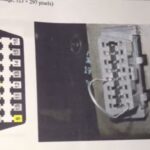The dreaded check engine light – it’s a sight no car owner wants to see illuminating their dashboard. When that light pops on, your vehicle’s onboard diagnostics system (OBD-II) is trying to tell you something. Often, this message comes in the form of a trouble code. Among the different types of OBD-II codes, Generic Obd2 Codes are the most common and universally applicable across vehicle makes and models.
Generic OBD2 codes are standardized codes used by all vehicle manufacturers to pinpoint common issues related to the powertrain system. These codes, typically starting with P0, P2, or P3, cover a wide range of potential problems, from minor sensor malfunctions to more significant engine or transmission issues. Understanding these codes is the first step in diagnosing and resolving your vehicle’s problems.
Decoding the Mystery of Generic OBD2 Powertrain Codes
Generic powertrain codes are the most frequently encountered OBD-II codes. They are designed to be consistent across all makes and models, making them a valuable starting point for any diagnostic process. These codes are structured in a specific way, providing key information about the system and component at fault.
- First Character (Letter): Indicates the system affected. “P” signifies Powertrain (engine and transmission).
- Second Character (Digit): Specifies the code type. “0” denotes a generic OBD-II code.
- Third Character (Digit): Indicates the subsystem. For example:
- 1: Fuel and Air Metering
- 2: Fuel and Air Metering (Injector Circuit)
- 3: Ignition System or Misfire
- 4: Auxiliary Emission Controls
- 5: Idle Control System and Auxiliary Inputs
- 6: Computer Output Circuit
- 7: Transmission
- 8: Transmission
- 9: Transmission
- A: Hybrid Propulsion System
- B: Hybrid Propulsion System
- C: Hybrid Propulsion System
- Fourth and Fifth Characters (Digits): These specify the specific fault within the identified subsystem.
For example, a code like P0171 (System Too Lean, Bank 1) breaks down as follows:
- P: Powertrain
- 0: Generic OBD-II Code
- 1: Fuel and Air Metering
- 71: Specific fault within fuel/air metering – System Too Lean, Bank 1
Understanding this structure can help you narrow down the potential causes of a problem even before consulting detailed code descriptions.
Navigating the Range of Generic OBD2 Codes: P0***, P2***, and P3***
While all generic powertrain codes follow the same structure, they are further categorized by their starting prefix. This website provides comprehensive lists to help you navigate these categories:
-
P0*** Codes: These are the most common generic powertrain codes, covering a broad spectrum of issues related to fuel and air metering, ignition systems, emission controls, and more. You can find detailed information on P0xxx codes by exploring our dedicated sections.
-
P2*** Generic Codes: This range of codes is also generic and powertrain-related, often focusing on more specific system faults or enhanced diagnostics within the powertrain.
-
P3*** Generic Codes: Generic P3 codes are less common but still part of the standardized OBD-II system. They may address certain transmission or auxiliary emission control issues.
An illuminated check engine light on a car dashboard, signaling potential issues diagnosed by the OBD-II system.
Beyond Generic Codes: When Manufacturer Specific Codes Come into Play
While generic OBD2 codes provide a solid foundation for diagnostics, it’s important to recognize their limitations. Manufacturers often use P1*** codes and other code ranges (B****, C****, U****) for manufacturer-specific issues. These codes address problems unique to a particular make or model and go beyond the scope of generic codes.
If you encounter a P1*** code, or codes from other categories like Body (B****), Chassis (C****), or Network (U****), you will need to consult manufacturer-specific resources for accurate diagnosis and repair guidance. Our website offers sections dedicated to these code types to help you find the information you need.
Utilizing Generic OBD2 Codes for Effective Vehicle Diagnostics
Generic OBD2 codes are an invaluable tool for car owners and technicians alike. They offer a standardized way to understand vehicle problems, providing a starting point for diagnosis and repair. When your check engine light illuminates, retrieving and understanding the generic OBD2 code is a crucial first step.
However, remember that a generic code is just the beginning of the diagnostic journey. While it points you in the right direction, further investigation, potentially including professional diagnosis, is often necessary to pinpoint the root cause and ensure a proper repair.
The OBD2 port typically located under the dashboard of a vehicle, used to connect diagnostic scanners for retrieving trouble codes.
Disclaimer: The information provided here is for informational purposes only and should not be considered repair advice. Always consult a qualified automotive technician for diagnosis and repair of vehicle issues. We are not responsible for any actions taken based on this information.
